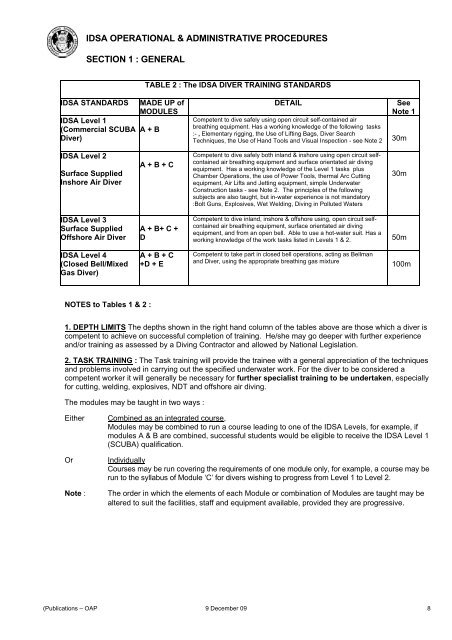International Diving Schools Association ______
International Diving Schools Association ______
International Diving Schools Association ______
You also want an ePaper? Increase the reach of your titles
YUMPU automatically turns print PDFs into web optimized ePapers that Google loves.
IDSA OPERATIONAL & ADMINISTRATIVE PROCEDURES<br />
SECTION 1 : GENERAL<br />
IDSA STANDARDS MADE UP of<br />
MODULES<br />
IDSA Level 1<br />
(Commercial SCUBA A + B<br />
Diver)<br />
IDSA Level 2<br />
Surface Supplied<br />
Inshore Air Diver<br />
IDSA Level 3<br />
Surface Supplied<br />
Offshore Air Diver<br />
IDSA Level 4<br />
(Closed Bell/Mixed<br />
Gas Diver)<br />
NOTES to Tables 1 & 2 :<br />
TABLE 2 : The IDSA DIVER TRAINING STANDARDS<br />
A + B + C<br />
A + B+ C +<br />
D<br />
A + B + C<br />
+D + E<br />
DETAIL See<br />
Note 1<br />
Competent to dive safely using open circuit self-contained air<br />
breathing equipment. Has a working knowledge of the following tasks<br />
:- , Elementary rigging, the Use of Lifting Bags, Diver Search<br />
Techniques, the Use of Hand Tools and Visual Inspection - see Note 2<br />
Competent to dive safely both inland & inshore using open circuit selfcontained<br />
air breathing equipment and surface orientated air diving<br />
equipment. Has a working knowledge of the Level 1 tasks plus<br />
Chamber Operations, the use of Power Tools, thermal Arc Cutting<br />
equipment, Air Lifts and Jetting equipment, simple Underwater<br />
Construction tasks - see Note 2. The principles of the following<br />
subjects are also taught, but in-water experience is not mandatory<br />
:Bolt Guns, Explosives, Wet Welding, <strong>Diving</strong> in Polluted Waters<br />
Competent to dive inland, inshore & offshore using, open circuit selfcontained<br />
air breathing equipment, surface orientated air diving<br />
equipment, and from an open bell. Able to use a hot-water suit. Has a<br />
working knowledge of the work tasks listed in Levels 1 & 2.<br />
Competent to take part in closed bell operations, acting as Bellman<br />
and Diver, using the appropriate breathing gas mixture<br />
(Publications – OAP 9 December 09 8<br />
30m<br />
30m<br />
50m<br />
100m<br />
1. DEPTH LIMITS The depths shown in the right hand column of the tables above are those which a diver is<br />
competent to achieve on successful completion of training. He/she may go deeper with further experience<br />
and/or training as assessed by a <strong>Diving</strong> Contractor and allowed by National Legislation.<br />
2. TASK TRAINING : The Task training will provide the trainee with a general appreciation of the techniques<br />
and problems involved in carrying out the specified underwater work. For the diver to be considered a<br />
competent worker it will generally be necessary for further specialist training to be undertaken, especially<br />
for cutting, welding, explosives, NDT and offshore air diving.<br />
The modules may be taught in two ways :<br />
Either Combined as an integrated course,<br />
Modules may be combined to run a course leading to one of the IDSA Levels, for example, if<br />
modules A & B are combined, successful students would be eligible to receive the IDSA Level 1<br />
(SCUBA) qualification.<br />
Or Individually<br />
Courses may be run covering the requirements of one module only, for example, a course may be<br />
run to the syllabus of Module ‘C’ for divers wishing to progress from Level 1 to Level 2.<br />
Note : The order in which the elements of each Module or combination of Modules are taught may be<br />
altered to suit the facilities, staff and equipment available, provided they are progressive.




